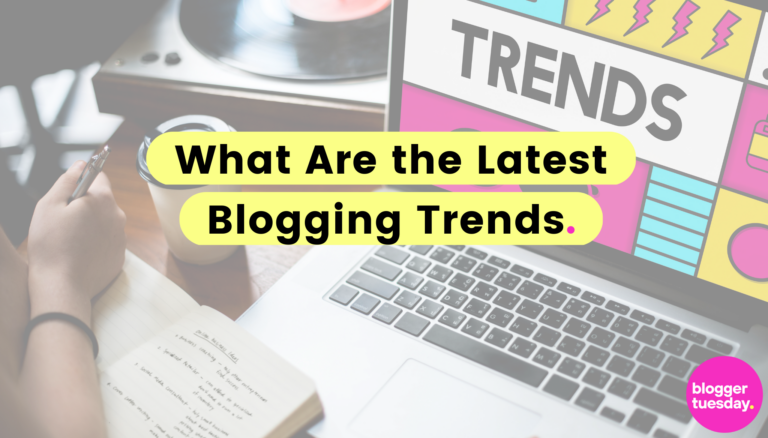Blogging trends evolve every year, but 2023 is shaping up to be particularly special. The next few months are unlikely to be like anything we’ve seen before, thanks partly to previously unthinkable technological developments. It’s a brave new world out there, and not always in a good way.
According to SEMrush, 409 million people read blogs monthly, generating 77 million comments and more than $418 billion in revenue. Moreover, blogging is still growing by more than 40 per cent annually, despite there already being more than 500 million active blogs online.
Therefore, bloggers who want to remain competitive must jump on the bandwagon. Here are the latest blogging trends and why you should implement them.
Content Experiences
Previously, bloggers would write content and add images to text before posting them through their CMS. This year, though, they are taking a leaf out of marketers’ books and focusing on “experiences” instead.
But what are those?
Fundamentally, experiences are about giving readers a good time, not just impeccable prose. They provide them with what they really want rather than something half-baked.
For example, suppose a reader arrives at a blog about skis. The content is there, but the page is full of intrusive ads, and they must continuously close pop-ups to see the page.
Does that sound like a quality experience? Clearly not.
Compare that to a blog with no annoying banners or interstitials, plenty of white space, interactive features, and a respectful call to action. That’s a totally different experience, and that’s now what serious bloggers are doing to stand out.
Multi-Platform Messaging
Blogging will also become distinctly more multi-platform and multi-media over the coming months. Instead of writing content for a blog URL, content creators will create accompanying media for other channels.
For example, some bloggers will turn prose into video presentations. Others will create stories for Instagram and Facebook. Some may even use blogs as the basis for their podcasts or radio stations.
Whatever it is, crossing platforms will become the norm. Creators will leverage all tools at their disposal to gain more impressions.
Again, the approach is reminiscent of conventional marketing. Bloggers will need to become omnichannel to be successful.
Data-Driven Content Analysis
This year is also seeing the rise of data-driven content analysis as bloggers try to figure out what their audiences want. Gut instinct will no longer be as important. Bloggers want to minimise creating unpopular content that works against their objectives.
Key performance indicators will come to the fore. Bloggers will analyse social media engagement, display ad metrics, and website search statistics. They will then use these to create a model of what their audience wants to consume.
Moreover, bloggers will not do this work alone. Many will rely on professional data crunchers and outsourced services to tell them what to do next.
Ultra-Visual Content
In keeping with trends in social media, bloggers will also move decisively towards ultra-visual content. Users no longer want to read paragraphs of dense text: they want easy-to-digest graphics and snippets to give them information.
Highly-visual content will move beyond pictures into animated charts and pictograms. Bloggers will use them for everything from straw polls to getting their points across. Videos and interactive media will take centre stage, providing audiences with an app-like experience and comprehensive insights.
Bloggers will also choose to push shareable ultra-visual content. Users are more likely to send punchy charts to their friends than text, helping creators grow their audiences.
Estimated Reading Times
2023 will also witness an expansion in reporting estimated reading times – something many well-known publishers do already.
Figures show readers are 40 per cent more engaged when consuming blogs with estimated reading times. They are also far more likely to remain on your pages, improving SEO.
Estimated reading times help bloggers set expectations. Audiences want to know what they are getting themselves into before diving into the introductory paragraph to avoid frustration later.
For example, readers who only have five minutes won’t want to start a 30-minute read. Instead, they’ll note it and save it for another day.
Similarly, a 2-minute read might be too brief for some researchers. Users may consider such posts as lacking depth to provide insights.
Including TL;DR Summaries
TL;DR (too long; didn’t read) summaries is another blogging trend. These are similar to abstracts at the start of academic papers, quickly reviewing the main points in the article.
Many bloggers are combining TL;DR summaries with estimated read times to increase engagement. With this approach, readers can get the gist of the content and then return to it later when they have more time.
TL;DR is also critical as attention spans drop. Some estimates suggest users can only concentrate for 8.25 seconds, around 30 per cent less than in 2000. A TL;DR summary appeals to the next generation of online readers
Originality Is Now A Priority
Originality is another compelling blogging trend. Creators are recognising the value of writing fresh material over regurgitating old ideas.
Technology is driving this change more than anything else. Bloggers know they need to outfox new generative large language models (LLMs), such as ChatGPT, if they want to succeed.
Bloggers also understand that originality is the only way to establish themselves as leaders in their field. Paraphrasing what’s already out there won’t work.
Evidence already supports this idea. According to Orbit Media, original blogs are 41 per cent more likely to be successful, up from 25 per cent in 2018.
Fake News Is More Convincing
Another trend is the rise in the quality of fake news. As technological capabilities grow, misinformation is becoming more convincing. Deep learning is helping firms adapt.
For trusted bloggers, these changes might be good news. Consumers will increasingly search out reputable sources of truth, leaving their social media enclaves.
Therefore, content creators who can establish a reputation for trust will see their reputation blossom. However, they must stay truthful and avoid falling prey to fake news themselves.
Writing In A Mobile-First Format
Another trend is the drive to write in a mobile-first format. Since 2015, users have been spending more time surfing the web on their phones than on desktops.
Therefore, bloggers must optimise their websites, blogs, and other digital content for mobile devices. A lack of mobile optimisation could cause users to leave your pages before reading what you have to say.
Email Marketing
Combining blogs with email marketing is also growing in importance. Businesses championed this idea many years ago, but bloggers are now seeing the benefits, too.
Support is available for content creators who want it. For instance, HubSpot offers a comprehensive set of email marketing tools to let creators promote their writing across numerous channels via a simple dashboard.
The best email marketing in 2023 focuses on personalisation and dynamic content. Bloggers are also including interactive email experiences, and using AI and machine learning to drive more effective email content.
Generative Blog Content
The use of generative blog content is also on the rise, even if it runs counter to originality. LLMs, such as ChatGPT, are now so powerful that many bloggers will be tempted to use them.
Machine-written text is now passable, even if it is dull. As such, writers will use it to bulk out their posts and save time.
Moreover, such approaches will become more common as new, better tools hit the market. For instance, Bing AI (currently in beta) overcomes ChatGPT’s limitations by automatically citing sources and including relevant, up-to-date content.
As writing engines improve, it will become more challenging to tell the difference between the musings of a machine and those of a person. Eventually, only the most original content will pass users’ sniff tests.
The Addition Of Affiliate Marketing
Another blogging trend is the implementation of affiliate marketing. Thirty-one per cent of publishers say it is among their top three sources of revenue.
Bloggers can implement affiliate marketing by mentioning companies’ products and reaching out to them to see if they offer any programmes. Most brands have incentives for creators willing to work with them.
Highly Critical Readers
Lastly, bloggers are witnessing a surge in critical readers – people who read their content with a sceptical eye. These individuals believe most internet-based content is unreliable or downright false, thanks to numerous scandals and “fake news.”
Therefore, bloggers are learning how to write for these users. To do this, they must:
- Write in high-quality prose
- Cite authoritative and consistent sources
- Publicly correct themselves when they get something wrong
- Avoid making any baseless claims
- Make use of footnotes or bibliographies
- Avoid promises they can’t deliver
Ultimately, bloggers need to do their homework in 2023. Writing anything their audiences can’t verify could damage their reputation.
Conclusion
Blogging isn’t dead, but it is changing. Ultimately, content creators need to be more creative. Paraphrasing existing content in a world replete with generative AIs and users with short attention spans won’t work. Only highly visual, original, and cleverly marketed content will do the trick.


